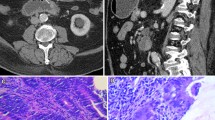Abstract
Multi-detector row computed tomography (MDCT) enables fast and thin acquisition of the abdominal anatomy. This allows multipass multi-planar studies that can be obtained during defined circulatory phases. When bolus timing is adequate, arterial phases with high contrast levels provide “free lunch” CT angiographies eliminating the need for diagnostic angiographies in most cases. In addition to established clinical indications for abdominal CT such as preoperative MDCT of the liver or pancreas, MDCT of the abdomen is especially gaining ground in the work up for acute abdominal pain and abdominal trauma and is opening new indications for MDCT of the gastrointestinal tract. Indications for gastrointestinal MDCT include tumors, bleeding and ischemia of the small and large bowel as well as diverticulitis. The question of whether to use positive or negative contrast material for bowel distention for MDCT of the gastrointestinal tract is still a controversial issue. In selected cases, modifying the protocol to perform a “CT enteroclysis” might improve sensitivity and specificity in depicting small bowel tumors or inflammatory changes such as in Crohn’s disease. The most common gastrointestinal mesenchymal tumor is the gastrointestinal stromal tumor (GIST).
MDCT may show hypervascular submucosal masses. Acute gastrointestinal (GI) bleeding is common with patients presenting with melena, hematemesis or hematochezia. In addition to the established initial work-up MDCT is beginning to establish itself for this indication. It may be especially helpful in the work up of obscure bleeding.
Another relatively rare but important cause for acute abdominal pain is mesenteric ischemia. It may be caused by many conditions and may mimic various intestinal diseases. Bowel ischemia severity ranges from transient superficial changes of the intestinal mucosa to life-threatening transmural bowel wall necrosis. CT can demonstrate changes in ischemic bowel segments accurately, is often helpful in determining the primary cause of ischemia, and can demonstrate important coexistent findings or complications.
Similar content being viewed by others
Author information
Authors and Affiliations
Corresponding author
Rights and permissions
About this article
Cite this article
Aschoff, A.J. MDCT of the abdomen. Eur Radiol Suppl 16 (Suppl 7), M54–M57 (2006). https://doi.org/10.1007/s10406-006-0196-z
Issue Date:
DOI: https://doi.org/10.1007/s10406-006-0196-z




